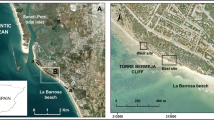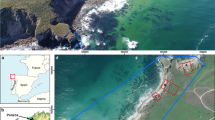Abstract
High-resolution digital elevation models (HRDEMs) on coastal areas, particularly cliffs, are an important asset for analyzing and quantifying the processes affecting their morphology. The Vaches-Noires coastal cliffs, located at the north-western part of the Pays-d’Auge region (Normandy, France), are an ideal site for the study of subaerial and marine erosion processes. Indeed, the coastline evolves through the accumulation of deposits resulting from rotational landslides and/or mudflows at the base of the cliff which are then undermined by the sea. The 3D modeling of a representative sector of the cliffs appears a suitable solution to monitor and quantify this evolution using HRDEMs. This paper presents the whole of a monitoring protocol, with high spatial resolution and high temporal resolution, on an original location characterized by reliefs of Badlands in coastal environments. The first results of these investigations are described with an evaluation of two methods for the creation of 3D models: a “heavy” method by Terrestrial Laser Scanning (TLS) monitoring, and a “light” method using “Structure from Motion” (SfM) terrestrial photogrammetry. The small investment of time in the field and money is an important asset of the SfM method. The textured rendering quality of the SfM model makes it a powerful tool for geomorphological analysis. According to a recurrent monitoring protocol involving both measurements, it was possible to compare the accuracy of the SfM and TLS models. The results show a high accuracy of the SfM models with an overall average error of 0.05 m. The representations of the zones of accumulation and erosion as well as their spatial succession allow to investigate the dynamics of the involved processes with both methods. Preliminary volume calculation results are conclusive for TLS models.











Similar content being viewed by others
References
Abellán A, Derron M-H, Jaboyedoff M (2016) “Use of 3D point clouds in geohazards” Special Issue: current challenges and futur trends. Remote Sens 8(2)
Auger P, Mary G (1968) Glissements et coulées boueuses en Basse-Normandie. Rev Géogr Phys Géol Dyn 2:213–224
Bretar F, Arab-Sedze M, Champion J, Pierrot-Deseilligny M, Heggy E, Jacquemoud S (2013) An advanced photogrammetric method to measure surface roughness: application to volcanic terrains in the Piton de la Fournaise, Reunion Island. Remote Sens Environ 135:1–11
Brodu N, Lague D (2012) 3D terrestrial lidar data classification of complex natural scenes using multi-scale dimensionality criterion: applications in geomorphology. ISPRS J Photogramm Remote Sens 68:121–134
Castillo C, Pérez R, James M, Quinton JN, Taguas EV, Gómez JA (2012) Comparing the accuracy of several field methods for measuring gully erosion. Soil Sci Soc Am J 76:1319–1332
Cawood AJ, Bond CE, Howell JA, Butler RWH, Totake Y (2017) LiDAR, UAV or compass-clinometer? Accuracy, coverage and the effects on structural models. J Struct Geol 98:67–82
Chiabrando F, Lingua A, Noardo F, Spano A (2014) 3D modelling of trompe l'oeil decorated vaults using dense matching techniques. ISPRS Annals of the Photogrammetry, Remote Sensing and Spatial Information Sciences II-5:97–104
Clapuyt F, Vanacker V, Van Oost K (2016) Reproducibility of UAV-based earth topography reconstructions based on structure-from-motion algorithms. Geomorphology 260:4–15
Dietrich JT (2016) Riverscape mapping withhelicopter-based structure-from-motion photogrammetry. Geomorphology 252:144–157
Eltner A, Baumgart P (2015) Accuracy constraints of terrestrial Lidar data for soil erosion measurement: application to a Mediterranean field plot. Geomorphology 245(15):243–254
Eltner A, Baumgart P, Maas HG, Faust D (2015) Multi-temporal UAV data for automatic measurement of rill and interrill erosion on loess soil. Earth Surf Process Landf 40:741–755
Eltner A, Kaiser A, Castillo C, Rock G, Neugirg F, Abellán A (2016) Image-based surface reconstruction in geomorphometry—merits, limits and developments. Earth Surface Dynamics 4:359–389
Favalli M, Fornaciai A, Isola I, Tarquini S, Nannipieri L (2012) Multiview 3D reconstruction in geosciences. Comput Geosci 44:168–176
Harwin S, Lucieer A (2012) Assessing the accuracy of georeferenced point clouds produced via multi-view stereopsis from unmanned aerial vehicle (UAV) imagery. Remote Sens 4(6):1573–1599
Hugenholtz CH, Whitehead K, Brown OW, Barchyn TE, Moorman BJ, LeClaire A, Riddell K, Hamilton T (2013) Geomorphological mapping with a small unmanned aircraft system (sUAS): feature detection and accuracy assessment of a photogrammetrically-derived digital terrain model. Geomorphology 194:16–24
Immerzeel WW, Kraaijenbrink A, Shea JM, Shrestha AB, Pellicciotti F, Bierkens MFP, De Jong SM (2014) High resolution monitoring of Himalayan glacier dynamics using unmanned aerial vehicles. Remote Sens Environ 150:93–103
Jaboyedoff M, Oppikofer T, Abellán A, Derron M-H, Loye A, Metzger R, Pedrazzini A (2012) Use of LIDAR in landslide investigations : a review. Natural Hazards, pp:5–28
James MR, Quinton JN (2014) Ultra-rapid topographic surveying for complex environments: the hand-held mobile laser scanner (HMLS). Earth Surf Process Landf 39(1):138–142
James MR, Robson S (2012) Straightforward reconstruction of 3D surfaces and topography with a camera: accuracy and geoscience application. Journal of Geophysical Research, vol 117
James MR, Robson S (2014) Mitigating systematic error in topographic models derived from UAV and ground-based image networks. Earth Surf Process Landf 39:1413–1420
Jaud M, Letortu P, Augereau E, Le Dantec N, Beauverger M, Cuq V., Prunier C, Le Bivic R, Delacourt C (in press) Pseudo-direct georeferencing of terrestrial laser scanning data for coastal landscape surveying. Eur J Remote Sens
Kaiser A, Neugirg F, Rock G, Müller C, Haas F, Ries J, Schmidt J (2014) Small-scale surface reconstruction and volume calculation of soil erosion in complex moroccan gully morphology using structure-from-motion. Remote Sens 6:7050–7080
Lague D, Brodu N, Leroux J (2013) Accurate 3D comparison of complex topography with terrestrial laser scanner: application to the Rangitikei canyon (N-Z). ISPRS J Photogramm Remote Sens 82:10–26
Letortu P, Costa S, Maquaire O, Delacourt C, Augereau E, Davidson R, Suanez S, Nabucet J (2015) Retreat rates, modalities and agents responsible for erosion along the coastal chalk cliffs of Upper Normandy: the contribution of terrestrial laser scanning. Geomorphology 245:3–14
Lowe, D. (1999) 'Object recognition from local scale-invariant features', Proceedings of the International Conference of Computer Vision, Corfu, Greece
Lowe D (2004) Distinctive image features from scale-invariant keypoints. Int J Comput Vis 60:91–110
Lucieer A, De Jong S, Turner D (2013) Mapping landslide displacements using structure from motion (SfM) and image correlation of multi-temporal UAV photography. Prog Phys Geogr 38:1–20
Mancini F, Dubbini M, Gattelli M, Stecchi F, Fabbri S, Gabbianelli G (2013) Using unmanned aerial vehicles (UAV) for high-resolution reconstruction of topography: the structure-from-motion approach on coastal environments. Remote Sens 5:6880–6898
Maquaire O, Malet JP (2006) Shallow landsliding., In: Boardman J, Poesen, J (eds) Soil erosion in Europe. Willy
Maquaire O, Afchain P, Launay A, Costa S, Lissak C, Fressard M, Letortu P, Davidson R, Thiery Y (2013) Evolution à long terme des falaises des 'Vaches Noires' et occurence des glissements (Calvados, Basse-Normandie, France). Recueil des actes des Journées 'Aléas Gravitaire', Grenoble, 17–18 septembre
Michelletti N, Chandler JH, Lane SN (2015) Investigating the geomorphological potential of freely available and accessible structure-from-motion photogrammetry using a smartphone. Earth Surf Process Landf 40:473–486
Nolan M, Larsen C, Sturm M (2015) Mapping snow depth from manned aircraft on landscape scales at centimeter resolution using structure-from-motion photogrammetry. Cryosphere 9:1445–1463
Nouwakpo SK, Weltz MA, McGuire K (2015) Assessing the performance of structure-from-motion photogrammetry and terrestrial lidar for reconstructing soil surface microtopography of naturally vegetated plots. Earth Surf Process Landf 41:308–322
Piermattei L, Carturan L, De Blasi F, Tarolli P, Dalla Fontana G, Vettore A, Pfeifer N (2016) Suitability of ground based SfM-MVS for monitoring glacial and periglacial processes. Earth Surface Dynamics 4:425–443
Prokop A, Panholzer H (2009) Assessing the capability of terrestrial laser scanning for monitoring slow moving landslides. Nat Hazards Earth Syst Sci 9:1924–1928
Prosdocimi M, Calligaro S, Sofia G, Dalla Fontana G, Tarolli P (2015) Bank erosion in agricultural drainage networks: new challenges from structure-from-motion photogrammetry for post-event analysis. Earth Surf Process Landf 40:1891–1906
Rippin DM, Pomfret A, King N (2015) High resolution mapping of supraglacial drainage pathways reveals link between micro-channel drainage density, surface roughness and surface reflectance. Earth Surf Process Landf 40:1279–1290
Roer I, Nyenhuis M (2007) Rockglacier activity studies on a regional scale: comparison of geomorphological mapping and photogrammetric monitoring. Earth Surf Process Landf 32:1747–1758
Ruggles S, Clark J, Franke KW, Wolfe D, Reimschiissel B, Martin RA, Okeson TJ, Hedengren JD (2016) Comparison of SfM computer vision point clouds of a landslide derived from multiple small UAV platforms and sensors to a TLS based model. Journal of Unmanned Vehicule Systems 4:246–265
Ružić I, Marovic I, Benac C, Ilic S (2014) Coastal cliff geometry derived from structure-from-motion photogrammetry at Stara Baka, Krk Island, Croatia. Geo-Mar Lett 34:555–565
Schürch PL, Densmore AJ, Rosser N, Lim MW, McArdell B (2011) Detection of surface change in complex topography using terrestrial laser scanning: application to the Illgraben debris-flow channel. Earth Surf Process Landf 36(14):1847–1859
Shan J, Toth CK (2008) Topographic laser ranging and scanning: principles and processing. CRC Press, Taylor & Francis
Slatcher N, James MR, Calvari S, Ganci G, Browning J (2015) Quantifying effusion rates at active volcanoes through integrated time-lapse laser scanning and photography. Remote Sens 7:14967–14987
Smith MW, Vericat D (2015) From experimental plots to experimental landscapes: topography, erosion and deposition in sub-humid badlands from structure-from-motion photogrammetry. Earth Surf Process Landf 40:1656–1671
Smith MW, Carrivick JL, Quincey DJ (2015) Structure from motion photogrammetry in physical geography. Prog Phys Geogr
Sofia G, Hillier JK, Conway SJ (2016) Frontiers in geomorphometry and earth surface dynamics: possibilities, limitations and perspectives. Earth Surface Dynamics 4:1–5
Stöcker C, Eltner A, Karrash P (2015) Measuring gullies by synergetic application of UAV and close range photogrammetry – a case study from Andalusia, Spain. Catena 132:1–11
Stumpf A, Malet JP, Allemand P, Pierrot-Deseilligny M, Skupinski G (2014) Ground-based multi-view photogrammetry for the monitoring of landslide deformation and erosion. Geomorphology 231:130–145
Tahar KN (2013) An evaluation on different number of ground control points in unmanned aerial vehicle photogrammetric block. ISPRS 8th 3DGeoInfo Conference & WG II/2 Workshop, Istanbul, Turkey, p 93–98
Teza G, Galgaro A, Zaltron N, Genevois R (2007) Terrestrial laser scanner to detect landslide displacement fields: a new approach. Int J Remote Sens 28:3425–3446
Tonkin TN, Midgley NG, Graham DJ, Labadz JC (2014) The potential of small unmanned aircraft systems and structure-from-motion for topographic surveys: a test of emerging integrated approaches at cwm Idwal, North Wales. Geomorphology 226:35–43
Tournadre V, Pierrot-Deseilligny M, Faure PH (2015) UAV linear photogrammetry. The International Archives of the Photogrammetry, Remote Sensing and Spatial Information Sciences, vol. XL-3/W3, p 327–333
Travelletti J, Malet JP, Samyn K, Grandjean G, Jaboyedoff M (2013) Control of landslide retrogression by discontinuities: evidence by the integration of airborn- and ground-based geophysical information. Landslides 10:37–54
Westoby MJ, Brasington J, Glasser NF, Hambrey MJ, Reynolds JM (2012) "structure-from-motion" photogrammetry: a low cost, effective tool for geoscience applications. Geomorphology 179:300–314
Wheaton JM, Brasington J, Darby SE (2009) Accounting for uncertainty in DEMs from repeat topographic surveys: improved sediment budgets. Earth Surf Process Landf 35(2):136–156
Woodget A, Carbonneau P, Visser F, Maddock I (2015) Quantifying submerged fluvial topography using hyperspatial resolution UAS imagery and structure from motion photogrammetry. Earth Surf Process Landf 40:47–64
Acknowledgements
The authors would like to thank Alexandre Thomas for his help during the first SfM acquisition and processing. This research was supported by several projects: the project “Developing Geomorphological mapping skills and datasets in anticipation of subsequent Susceptibility, Vulnerability, Hazard and Risk Mapping” funded by the EUR-OPA European Major Hazards Agreement of the Council of Europe; the ANR project “RICOCHET: multi-RIsk assessment on Coastal territory in a global CHange context” funded by the French Research National Agency (ANR-16-CE03-0008); the Normandy Regional Council via the M2NUM project and the Cerema APHOGEOPHY project.
Author information
Authors and Affiliations
Corresponding author
Rights and permissions
About this article
Cite this article
Medjkane, M., Maquaire, O., Costa, S. et al. High-resolution monitoring of complex coastal morphology changes: cross-efficiency of SfM and TLS-based survey (Vaches-Noires cliffs, Normandy, France). Landslides 15, 1097–1108 (2018). https://doi.org/10.1007/s10346-017-0942-4
Received:
Accepted:
Published:
Issue Date:
DOI: https://doi.org/10.1007/s10346-017-0942-4




